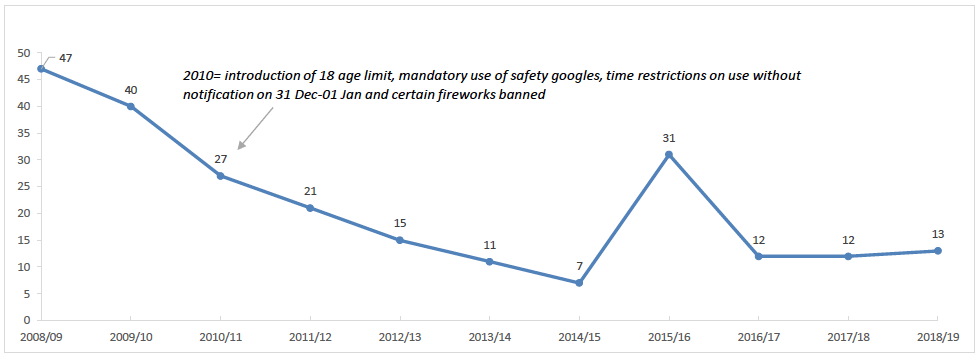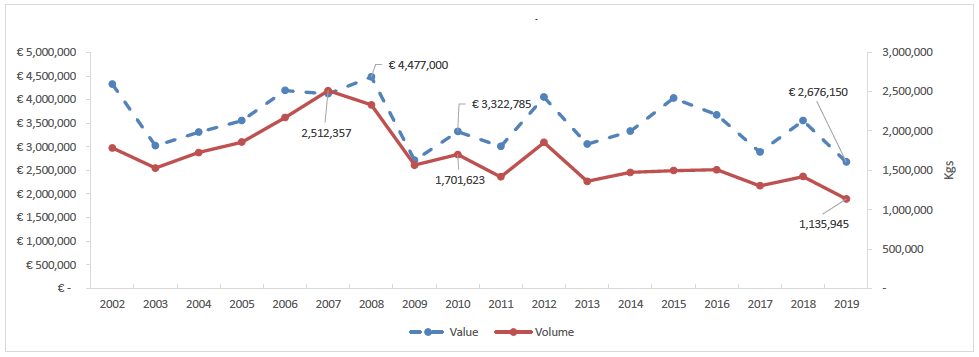Fireworks regulations - impact: case studies
This paper consists of seven case studies, each one aligned to one or more of the legislative options being considered by the Firework Review Group.
Finland
Main points
- Evidence indicates that there was a marked decline in the number of bystanders and firework users sustaining fireworks-related eye injuries following the enactment of a set measures in 2010. These included: mandatory wearing of safety goggles for firework users, time restrictions on use on New Year's Eve, minimum age of 18 and prohibition of certain fireworks.
- Evidence suggests that the mandatory wearing of safety goggles for firework users, helped mitigate against more severe eye injuries being sustained.
- By far the two most common firework offences concern those under 18 possessing fireworks and using fireworks out-with the designated window on 31 December and 01 January, both have varied annually with sizeable rises and falls.
- The annual volume (Kgs) of firework imports has generally been lower since 2013 compared to before the introduction of regulations in 2010.
Current fireworks regulations
- All firework users must wear safety glasses
- Consumer fireworks cannot be bought or used by those aged under 18
- It is illegal to sell or pass on fireworks to anyone aged under 18
- Local rescue authorities must be notified about the use of consumer fireworks at least five days before the event. The rescue authorities may prohibit the use of fireworks, or set the user some terms and restrictions necessary to their safety.
- Consumer fireworks can be used without notification from 18:00 on 31 December until 02:00 on 01 January
- Some municipalities have banned the use of fireworks, whilst others have prohibited their use in city centres
- Aligned legislative options: D, E, K (mandatory use of safety googles)
Policy background
In Finland the use of safety goggles had been advocated by safety campaigners since 1999 and in 2010 it became mandatory by law for everyone igniting a firework to wear them. In addition to the laws on safety googles, a number of other significant changes were made to fireworks regulations in 2010. It became illegal to either sell fireworks or give them to persons younger than 18 years of age; two classes of smaller fireworks were banned (Roman candles[26] and bottle rockets) and the time restrictions on when fireworks can be used on 31 December-01 January were introduced[27].
Impact of regulations: eye injuries
The Finnish Ophthalmological Society has collaborated with the Finnish Safety and Chemical Agency and the Helsinki University Eye Hospital for two decades, organising national data collections. This includes an annual survey of fireworks-related eye injuries treated in all hospitals by ophthalmologists[28]. As part of a combined study with the Netherlands (covered in the Netherlands case study), de Feber et al[29] analysed data from 2009-2019 in order to assess the influence of fireworks regulations and safety campaigns on eye injuries.
Trend data for 2008/09-2018/19 is presented in Graph 3. The graph shows a substantial drop in 2010/11 (from 40 to 27) in the number of persons treated by an ophthalmologist in hospital for a firework-related injury, coinciding with the implementation of regulations including the mandatory use of safety googles, time restrictions, minimum age raised to 18 and the prohibition of certain fireworks. From 2011/12 there was a steady annual decrease, suggesting the 2010 changes were having a continued effect. The figure has remained steady since 2016/17. Looking across the span of the time series, the number of persons treated decreased from 47 in 2008/09 to 13 in 2018/19.

Source: National studies from the Netherlands and Finland and the impact of regulations on incidences of fireworks-related eye injuries, 2020
Table 4 provides a breakdown of the figures according to whether the injured person was a bystander or a fireworks user. This shows that the number of bystanders and firework users (self-inflicted) experiencing fireworks-related eye injuries, has been lower following the introduction of the 2010 regulations, although the numbers have varied annually. The 2015/16 spike in the total number would appear to have been largely driven by a sizeable increase amongst firework users, as the number increased from 3 in 2014/15 to 23 in 2015/16, compared to an increase from 4 to 8 amongst bystanders.
Table 4 also includes information on the category of eye injury sustained: mild, moderate and severe. Across the time series, there has been a decline in all three. Whilst a gap in the data for this breakdown (2010/11) makes it more difficult to assess the immediate influence of the 2010 regulations, it would appear that they had some effect as the figures from 2011/12 onwards tend to be somewhat lower than earlier years. The study notes that those who sustained eye injuries following the mandatory requirement for safety googles to be worn, typically have not worn them or wearing the glasses mitigated against a more severe injury. The authors conclude that the use of safety googles has helped reduce the number of people suffering severe eye injuries. However, the study was not able to isolate the impact of safety goggles from the other measures introduced simultaneously.
| 2008/09 | 2009/10 | 2010/11 | 2011/12 | 2012/13 | 2013/14 | 2014/15 | 2015/16 | 2016/17 | 2017/18 | 2018/19 | |
|---|---|---|---|---|---|---|---|---|---|---|---|
| Injured persons | 47 | 40 | 27 | 21 | 15 | 11 | 7 | 31 | 12 | 12 | 13 |
| Self-inflicted | 31 | ~ | 20 | 14 | 11 | 4 | 3 | 23 | 7 | 6 | 10 |
| Bystanders | 16 | ~ | 7 | 7 | 4 | 7 | 4 | 8 | 5 | 6 | 3 |
| Mild eye damage | 24 | 23 | ~ | 13 | 5 | 8 | 3 | 16 | 5 | 6 | 2 |
| Moderate eye damage | 12 | 13 | ~ | 4 | 5 | 2 | 3 | 10 | 5 | 4 | 8 |
| Severe eye damage | 11 | 4 | ~ | 4 | 5 | 1 | 1 | 5 | 2 | 2 | 3 |
2010= introduction of 18 age limit, mandatory use of safety googles, time restrictions on use without notification on 31 Dec-01 Jan and certain fireworks banned
~ denotes years when there was incomplete data from one or more hospitals.
Source: ‘National studies from the Netherlands and Finland and the impact of regulations on incidences of fireworks-related eye injuries’, 2020
Impact of regulations: crime
Statistics Finland were able to provide data relating to specific fireworks offences from 2010 to 2019 and this is presented in Table 5. Across the time series, by far the most common reported firework offences concern failing to comply with the restriction on when fireworks can be used and possessing fireworks when under the age of 18. There is no increasing or decreasing trend for either offence, instead both have varied annually with sizeable rises and falls. The number of violations of the other firework provisions are low.
| 2010 | 2011 | 2012 | 2013 | 2014 | 2015 | 2016 | 2017 | 2018 | 2019 | |
|---|---|---|---|---|---|---|---|---|---|---|
| Did not comply with the obligation to report the use of fireworks by firing fireworks at a time other than 31 December from 6pm to 2am | 26 | 62 | 40 | 55 | 23 | 38 | 34 | 35 | 21 | 29 |
| Did not comply with the obligation to wear goggles when using fireworks | 3 | 2 | 3 | 8 | 2 | 1 | 4 | 4 | 2 | 2 |
| Did not comply with the regional ban on the use of fireworks issued by the rescue authority | 1 | 10 | 12 | 8 | 7 | 7 | 6 | 8 | 7 | 8 |
| Delivered explosives (fireworks) to a person under the age of 18 with a delivery age of 18 years | 3 | 15 | 14 | 12 | 6 | 6 | 4 | - | 6 | 2 |
| Held fireworks under the age of 18 with a delivery limit of 18 years | 25 | 74 | 55 | 43 | 31 | 41 | 21 | 25 | 49 | 29 |
| In possession of fireworks intoxicated | 4 | 10 | 8 | 12 | 4 | 3 | 6 | 2 | - | 3 |
| Total | 62 | 173 | 132 | 138 | 73 | 96 | 75 | 74 | 85 | 73 |
Source: Statistics Finland
Impact of regulations: imports
Finnish Customs publishes data on international trade, including the value (€) and volume (Kg) of fireworks[30] imports. Data from 2002 to 2019 is presented in Graph 4. It is important to note that this incorporates all firework imports, not just those for public use.
Generally speaking, the value and volume of fireworks imports to Finland have followed similar trends over the years. Both peaked prior to the introduction of restrictions in 2010 (value 2008, volume 2007) before a sizeable decline in 2009. The two measures increased in 2012 but were fairly stable until 2018 (with the exception of an increase in value in 2015). It is difficult to decipher how the fireworks regulations correspond to imports. The fact that the volume of imports has been consistently lower in recent years than the early to mid-2000s, could point to the regulations having a gradual effect.

Source: Finnish Customs, ULJAS International Trade Statistics
Contact
Email: socialresearch@gov.scot
There is a problem
Thanks for your feedback